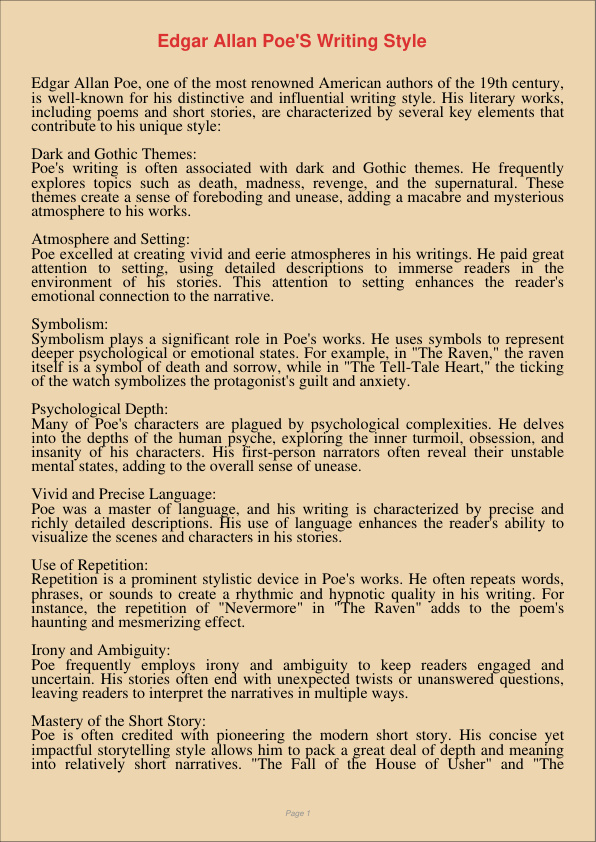Edgar Allan PoeS Writing Style
Jan 8, 2024
edgar allan poe
writing style
Literature
Philosophy
Edgar Allan Poe, one of the most renowned American authors of the 19th century, is well-known for his distinctive and influential writing style. His literary works, including poems and short stories, are characterized by several key elements that contribute to his unique style:
Dark and Gothic Themes: Poe’s writing is often associated with dark and Gothic themes. He frequently explores topics such as death, madness, revenge, and the supernatural. These themes create a sense of foreboding and unease, adding a macabre and mysterious atmosphere to his works.
Atmosphere and Setting: Poe excelled at creating vivid and eerie atmospheres in his writings. He paid great attention to setting, using detailed descriptions to immerse readers in the environment of his stories. This attention to setting enhances the reader’s emotional connection to the narrative.
Symbolism: Symbolism plays a significant role in Poe’s works. He uses symbols to represent deeper psychological or emotional states. For example, in “The Raven,” the raven itself is a symbol of death and sorrow, while in “The Tell-Tale Heart,” the ticking of the watch symbolizes the protagonist’s guilt and anxiety.
Psychological Depth: Many of Poe’s characters are plagued by psychological complexities. He delves into the depths of the human psyche, exploring the inner turmoil, obsession, and insanity of his characters. His first-person narrators often reveal their unstable mental states, adding to the overall sense of unease.
Vivid and Precise Language: Poe was a master of language, and his writing is characterized by precise and richly detailed descriptions. His use of language enhances the reader’s ability to visualize the scenes and characters in his stories.
Use of Repetition: Repetition is a prominent stylistic device in Poe’s works. He often repeats words, phrases, or sounds to create a rhythmic and hypnotic quality in his writing. For instance, the repetition of “Nevermore” in “The Raven” adds to the poem’s haunting and mesmerizing effect.
Irony and Ambiguity: Poe frequently employs irony and ambiguity to keep readers engaged and uncertain. His stories often end with unexpected twists or unanswered questions, leaving readers to interpret the narratives in multiple ways.
Mastery of the Short Story: Poe is often credited with pioneering the modern short story. His concise yet impactful storytelling style allows him to pack a great deal of depth and meaning into relatively short narratives. “The Fall of the House of Usher” and “The Tell-Tale Heart” are excellent examples of his ability to create powerful short stories.
Musicality and Rhythm: Poe’s works often exhibit a musical quality and rhythm in their prose and poetry. He carefully chose words and structured sentences to create a melodious and hypnotic effect, which contributes to the immersive nature of his writing.
In conclusion, Edgar Allan Poe’s writing style is characterized by its dark and Gothic themes, vivid descriptions, symbolism, psychological depth, repetition, irony, and a meticulous attention to language. His ability to evoke emotions and create an atmosphere of unease has made him an enduring and influential figure in American literature.
